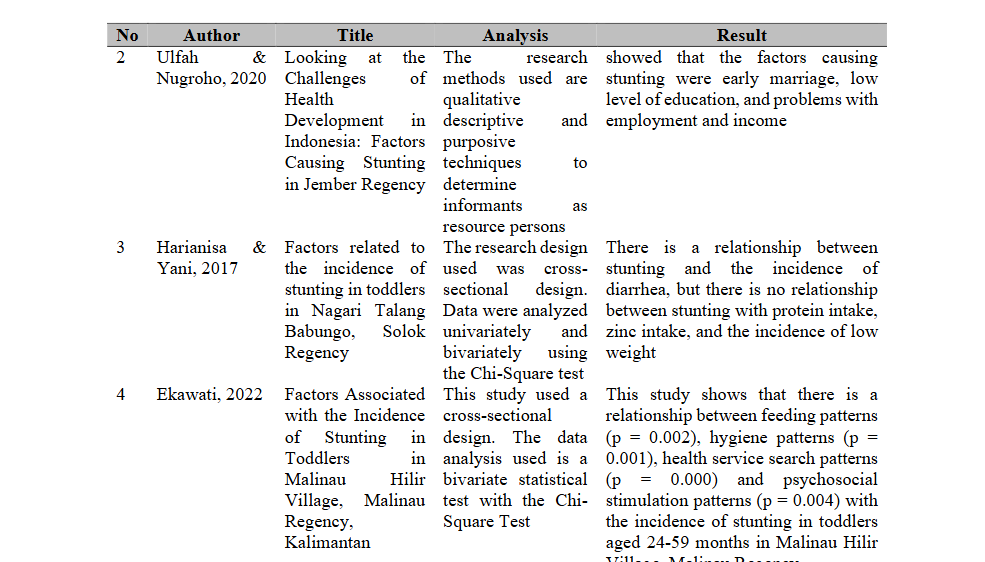The Analysis of Factors that Influence Stunting
DOI:
https://doi.org/10.26699/jnk.v11i2.ART.p200-208Keywords:
Influencing Factors, Stunting, ToddlersAbstract
Stunting in children is a national problem caused by many factors that harm human resources in the future, including an impact on decreasing intelligence, vulnerability to disease, hampering economic growth, work productivity, exacerbating inequality, and height growth is shorter than age in general. Stunting in children under five is a consequence of several factors that are often associated with poverty, including nutrition, health, sanitation, and the environment There are five main factors that cause stunting, namely poverty, social and cultural, increased exposure to infectious diseases, food insecurity and community access to health service. The purpose of this literature review was to analyze the factors that influence stunting. The article was obtained from a SINTA accredited journal published in the 2013-2023 period with the same title, as well as the same research design. The selected articles were then tested for plagiarism, and nine articles with the smallest plagiarism level were selected. Analysis PICO (Population, Intervention, Comparison, Outcome) is carried out on each article, followed by making conclusions. The results of the analysis determined that factors that influence stunting include social and cultural, increased exposure to infectious diseases, food insecurity and community access to health services alone or together. The author hopes that this research will further greatly help how to do health promotion, case finding and prevention, and, many sectors must be involved and work together for the problem of stunting.
References
Amalia, A. A., Tiwery, I. B., Widiansari, F. E., & Purnamasari, J. (2024). Permasalahan dan Kebutuhan Kesehatan Terkait Pencegahan Stunting. Penerbit NEM.
Beal, T., Tumilowicz, A., Sutrisna, A., Izwardy, D., & Neufeld, L. M. (2018). A review of child stunting determinants in Indonesia. Maternal and Child Nutrition, 14(4), 1–10. https://doi.org/10.1111/mcn.12617
de Onis, M., & Branca, F. (2016). Childhood stunting: A global perspective. Maternal and Child Nutrition, 12, 12–26. https://doi.org/10.1111/mcn.12231
Dessie, Z. B., Fentie, M., Abebe, Z., Ayele, T. A., & Muchie, K. F. (2019). Maternal characteristics and nutritional status among 6-59 months of children in Ethiopia: Further analysis of demographic and health survey. BMC Pediatrics, 19(1), 1–10. https://doi.org/10.1186/s12887-019-1459-x
Dewanti, C., Ratnasari, V., & Rumiati, A. T. (2020). Pemodelan Faktor-Faktor yang Memengaruhi Status Balita Stunting di Provinsi Jawa Timur Menggunakan Regresi Probit Biner. Jurnal Sains Dan Seni ITS, 8(2). https://doi.org/10.12962/j23373520.v8i2.48519
Ekawati, G., & Rokhaidah. (2022). Faktor-Faktor yang Berhubungan Dengan Kejadian Stunting Pada Balita di Desa Malinau Hilir Kabupaten Malinau Kalimantan Tahun 2021. Media Informasi, 18(2), 52–59. https://doi.org/10.37160/bmi.v18i2.17
Fariza, A., Asmara, R., & Istiqomah, G. N. (2023). Visualisasi Spasial Temporal Tingkat Risiko Stunting di Jawa Timur Menggunakan Metode Fuzzy Spatial Temporal Visualization of Stunting Risk Level in East Java Using Fuzzy Method. Jurnal Teknologi Dan Informasi (JATI), 13(1), 83–95. https://doi.org/10.34010/jati.v13i1
Harianisa, S., Yani, I. E., Andrafikar, & Franchfi. (2021). Faktor-Faktor yang Berhubungan dengan Kejadian Stunting pada Balita di Nagari Talang Babungo, Kabupaten Solok. Seminar Nasional Syedza Saintika, 12. https://jurnal.syedzasaintika.ac.id/index.php/PSNSYS/article/view/920/655
Hendra, A., Rahmad, A. L., & Miko, A. (2016). Kajian Stunting Pada Anak Balita Berdasarkan Pola Asuh Dan Pendapatan Keluarga Di Kota Banda Aceh S in Banda Aceh. Jurnal Kesmas Indonesia8, 63–79. https://jos.unsoed.ac.id/index.php/kesmasindo/article/view/151hen
Laksono, A. D., & Megatsari, H. (2020). Determinan Balita Stunting di Jawa Timur: Analisis Data Pemantauan Status Gizi 2017. Amerta Nutrition, 4(2), 109. https://doi.org/10.20473/amnt.v4i2.2020.109-115
Nugraheni, D., Nuryanto, N., Wijayanti, H. S., Panunggal, B., & Syauqy, A. (2020). Asi Eksklusif Dan Asupan Energi Berhubungan Dengan Kejadian Stunting Pada Usia 6 – 24 Bulan Di Jawa Tengah. Journal of Nutrition College, 9(2), 106–113. https://doi.org/10.14710/jnc.v9i2.27126
Nugroho, M. R., Sasongko, R. N., & Kristiawan, M. (2021). Faktor-faktor yang Mempengaruhi Kejadian Stunting pada Anak Usia Dini di Indonesia. Jurnal Obsesi : Jurnal Pendidikan Anak Usia Dini, 5(2), 2269–2276. https://doi.org/10.31004/obsesi.v5i2.1169
Pillai, V. K., & Maleku, A. (2019). Women’s education and child stunting reduction in India. Journal of Sociology and Social Welfare, 46(3), 111–130. https://doi.org/10.15453/0191-5096.4203
Purnama, N. L. A. (2023). Gambaran Faktor Resiko Stunting Balita di Desa Siwalanpanji Kabupaten Sidoarjo Jawa Timur. Malahayati Nursing Journal, 5(3), 701–713. https://doi.org/10.33024/mnj.v5i3.8088
Rahayu, Y. D., Yunariyah, B., & Jannah, R. (2022). Gambaran Faktor Penyebab Kejadian Stunting Pada Balita Di Wilayah Kerja Puskesmas Semanding Tuban. Jurnal Kesehatan Masyarakat, 10(2), 156–162. https://doi.org/10.14710/jkm.v10i2.32271
Rahmawati, N. F., Fajar, N. A., & Idris, H. (2020). Faktor sosial, ekonomi, dan pemanfaatan posyandu dengan kejadian stunting balita keluarga miskin penerima PKH di Palembang. Jurnal Gizi Klinik Indonesia, 17(1), 23. https://doi.org/10.22146/ijcn.49696
Ratih, R., Kartinawati, K. T., Darwata, I. W., & Yanti, N. K. R. R. (2022). Faktor- faktor yang Mempengaruhi Kejadian Stunting pada Anak Usia 2-5 tahun di Puskesmas Ubud 1 Gianyar. E-Journal AMJ (Aesculapius Medical Journal), 2(1), 26–34. https://doi.org/10.22225/amj.2.1.2022.26-34
Sulaeman, & Purnama, J. (2022). Faktor-Faktor yang Mempengaruhi Kejadian Stunting Pada Balita di Wilayah Kerja Puskesmas Lompoe Kota Parepare. Jurnal Ilmiah Mappadising, 4(2), 299–307. https://doi.org/10.54339/mappadising.v4i1.448
Supariasa, I. D. N., & Purwaningsih, H. (2019). faktor-faktor yang mempengaruhi kejadian stunting pada balita di Kabupaten Malang. Karta Rahardja, 1(2), 55–64. https://ejurnal.malangkab.go.id/index.php/kr/article/view/21
Tekile, A. K., Woya, A. A., & Basha, G. W. (2019). Prevalence of malnutrition and associated factors among under-five children in Ethiopia: Evidence from the 2016 Ethiopia Demographic and Health Survey. BMC Research Notes, 12(1), 1–6. https://doi.org/10.1186/s13104-019-4444-4
Ulfah, I. F., & Nugroho, A. B. (2020). Menilik Tantangan Pembangunan Kesehatan di Indonesia: Faktor Penyebab Stunting di Kabupaten Jember. Jurnal Sosial Politik, 6(2), 201–213. https://doi.org/10.22219/sospol.v6i2.12899
Vilcins, D., Sly, P. D., & Jagals, P. (2018). Environmental risk factors associated with child stunting: A systematic review of the literature. Annals of Global Health, 84(4), 551–562. https://doi.org/10.29024/aogh.2361
Yuwanti, Y., Mulyaningrum, F. M., & Susanti, M. M. (2021). Faktor – Faktor Yang Mempengaruhi Stunting Pada Balita Di Kabupaten Grobogan. Jurnal Keperawatan Dan Kesehatan Masyarakat Cendekia Utama, 10(1), 74. https://doi.org/10.31596/jcu.v10i1.704

Downloads
Published
How to Cite
Issue
Section
License
Copyright (c) 2024 Jurnal Ners dan Kebidanan (Journal of Ners and Midwifery)

This work is licensed under a Creative Commons Attribution-ShareAlike 4.0 International License.


 Google Scholar
Google Scholar Sinta
Sinta
 Google Scholar
Google Scholar Sinta
Sinta ORCID
ORCID



